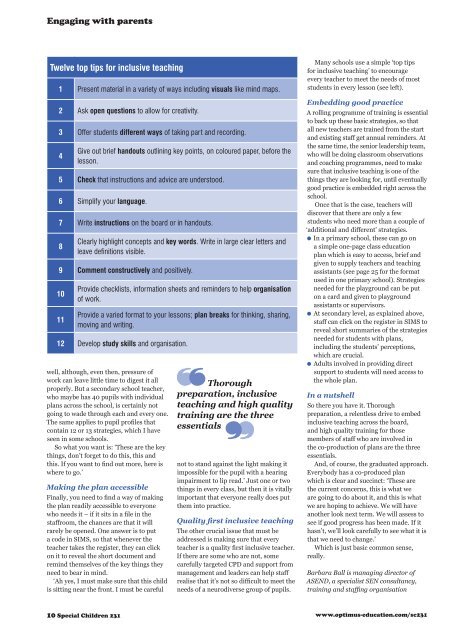champions
1H1C301qFr9
1H1C301qFr9
You also want an ePaper? Increase the reach of your titles
YUMPU automatically turns print PDFs into web optimized ePapers that Google loves.
Engaging with parents<br />
Twelve top tips for inclusive teaching<br />
1 Present material in a variety of ways including visuals like mind maps.<br />
2 Ask open questions to allow for creativity.<br />
3 Offer students different ways of taking part and recording.<br />
4<br />
Give out brief handouts outlining key points, on coloured paper, before the<br />
lesson.<br />
5 Check that instructions and advice are understood.<br />
6 Simplify your language.<br />
7 Write instructions on the board or in handouts.<br />
8<br />
Clearly highlight concepts and key words. Write in large clear letters and<br />
leave definitions visible.<br />
9 Comment constructively and positively.<br />
10<br />
11<br />
Provide checklists, information sheets and reminders to help organisation<br />
of work.<br />
Provide a varied format to your lessons; plan breaks for thinking, sharing,<br />
moving and writing.<br />
12 Develop study skills and organisation.<br />
well, although, even then, pressure of<br />
work can leave little time to digest it all<br />
properly. But a secondary school teacher,<br />
who maybe has 40 pupils with individual<br />
plans across the school, is certainly not<br />
going to wade through each and every one.<br />
The same applies to pupil profiles that<br />
contain 12 or 13 strategies, which I have<br />
seen in some schools.<br />
So what you want is: ‘These are the key<br />
things, don’t forget to do this, this and<br />
this. If you want to find out more, here is<br />
where to go.’<br />
Making the plan accessible<br />
Finally, you need to find a way of making<br />
the plan readily accessible to everyone<br />
who needs it – if it sits in a file in the<br />
staffroom, the chances are that it will<br />
rarely be opened. One answer is to put<br />
a code in SIMS, so that whenever the<br />
teacher takes the register, they can click<br />
on it to reveal the short document and<br />
remind themselves of the key things they<br />
need to bear in mind.<br />
‘Ah yes, I must make sure that this child<br />
is sitting near the front. I must be careful<br />
Thorough<br />
preparation, inclusive<br />
teaching and high quality<br />
training are the three<br />
essentials<br />
not to stand against the light making it<br />
impossible for the pupil with a hearing<br />
impairment to lip read.’ Just one or two<br />
things in every class, but then it is vitally<br />
important that everyone really does put<br />
them into practice.<br />
Quality first inclusive teaching<br />
The other crucial issue that must be<br />
addressed is making sure that every<br />
teacher is a quality first inclusive teacher.<br />
If there are some who are not, some<br />
carefully targeted CPD and support from<br />
management and leaders can help staff<br />
realise that it’s not so difficult to meet the<br />
needs of a neurodiverse group of pupils.<br />
Many schools use a simple ‘top tips<br />
for inclusive teaching’ to encourage<br />
every teacher to meet the needs of most<br />
students in every lesson (see left).<br />
Embedding good practice<br />
A rolling programme of training is essential<br />
to back up these basic strategies, so that<br />
all new teachers are trained from the start<br />
and existing staff get annual reminders. At<br />
the same time, the senior leadership team,<br />
who will be doing classroom observations<br />
and coaching programmes, need to make<br />
sure that inclusive teaching is one of the<br />
things they are looking for, until eventually<br />
good practice is embedded right across the<br />
school.<br />
Once that is the case, teachers will<br />
discover that there are only a few<br />
students who need more than a couple of<br />
‘additional and different’ strategies.<br />
●●In a primary school, these can go on<br />
a simple one-page class education<br />
plan which is easy to access, brief and<br />
given to supply teachers and teaching<br />
assistants (see page 25 for the format<br />
used in one primary school). Strategies<br />
needed for the playground can be put<br />
on a card and given to playground<br />
assistants or supervisors.<br />
● ● At secondary level, as explained above,<br />
staff can click on the register in SIMS to<br />
reveal short summaries of the strategies<br />
needed for students with plans,<br />
including the students’ perceptions,<br />
which are crucial.<br />
● ● Adults involved in providing direct<br />
support to students will need access to<br />
the whole plan.<br />
In a nutshell<br />
So there you have it. Thorough<br />
preparation, a relentless drive to embed<br />
inclusive teaching across the board,<br />
and high quality training for those<br />
members of staff who are involved in<br />
the co-production of plans are the three<br />
essentials.<br />
And, of course, the graduated approach.<br />
Everybody has a co-produced plan<br />
which is clear and succinct: ‘These are<br />
the current concerns, this is what we<br />
are going to do about it, and this is what<br />
we are hoping to achieve. We will have<br />
another look next term. We will assess to<br />
see if good progress has been made. If it<br />
hasn’t, we’ll look carefully to see what it is<br />
that we need to change.’<br />
Which is just basic common sense,<br />
really.<br />
Barbara Ball is managing director of<br />
ASEND, a specialist SEN consultancy,<br />
training and staffing organisation<br />
10 Special Children 231<br />
www.optimus-education.com/sc231


